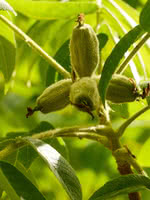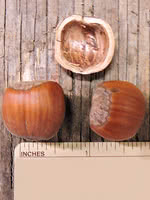Mon-Fri 9am - 5pm Mountain time
Butternut (White Walnut) vs Andrew Hazelnut
Juglans cinerea
Corylus heterophylla Het 1
NOT AVAILABLE THIS SEASON - MIGHT RETURN
Butternut is one of the few walnut varieties native to Canada. The nuts are sought after for their mild, sweet, and oily taste. Ensure this tree is planted in full sun and well-drained soil for best results.
Butternut is self-fertile but it has better yields when planted near other butternuts. It can survive in zone 2, but reliably produces nuts in zone 3.
A top CO2 absorbing species. Experts think this tree may help climate change more than others.
Andrew Hazelnut is a northern cultivar that is grown specifically for its cold hardiness. Typically, hazelnuts produce smaller nuts in colder climates, but for Andrew Hazelnut, this is not the case.
This hybrid variety is incredibly productive, growing medium sized nuts that ripen in late August. Pair with another Andrew or Aldara Hazelnut for cross pollination to occur.
The edible nuts can be eaten fresh, used in baking, and will make a beautiful hedge. Andrew Hazelnut is also eastern filbert blight resistant.
Note: You want more than one hazelnut to improve yields.

